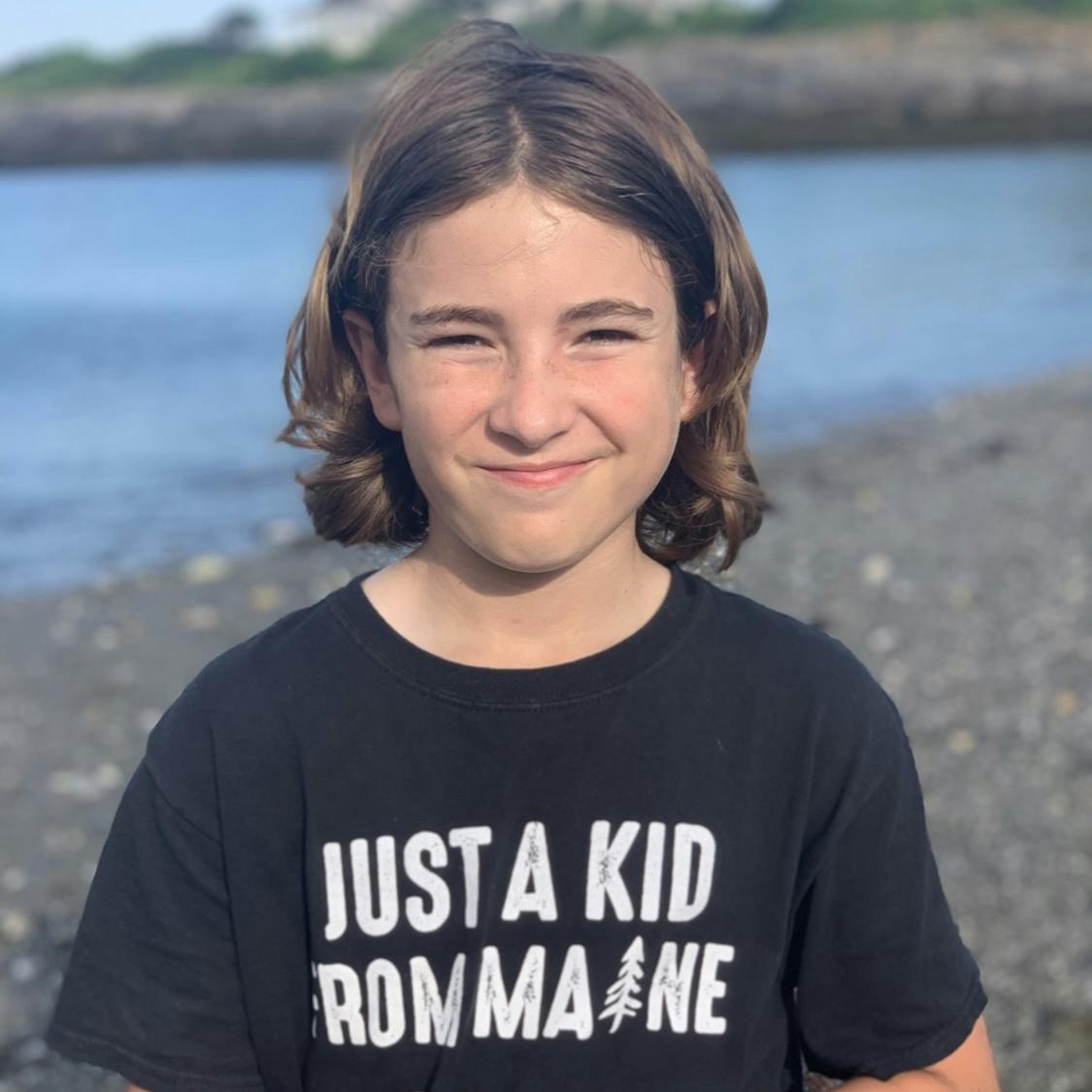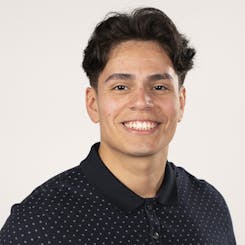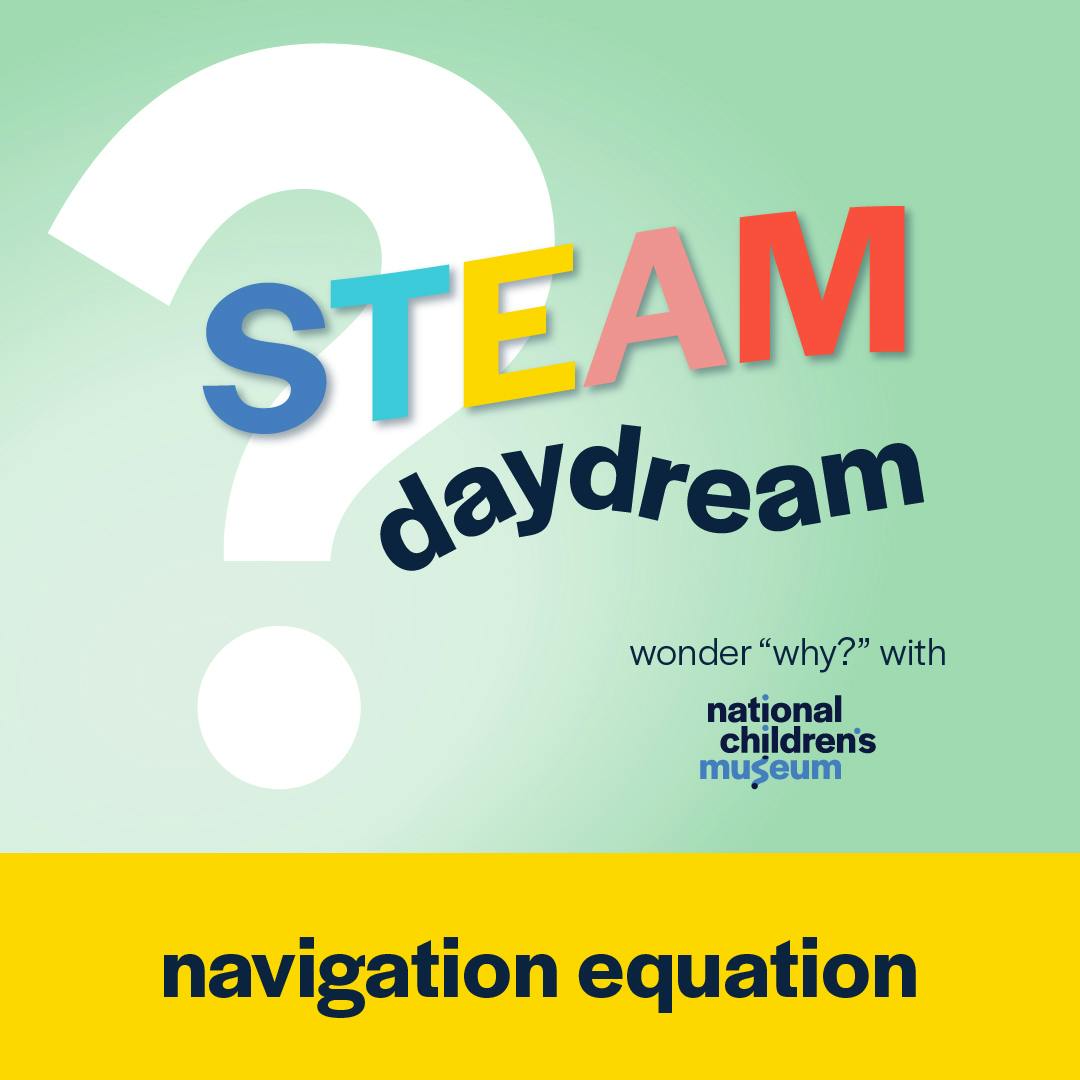navigation equation
When Aubrey, Andre, Newton, and 12-year old Kid Investigator Will C. hit the road with only a printed map and Aubrey’s thinking cap to guide them, they quickly become lost. After one too many wrong turns, they turn to GPS for directions to get home—but where do the directions come from? GEICO software engineer Cesar Alcantara helps point them in the right direction.
 meet our kid investigator Will C. (he/him) from Cape Elizabeth, Maine 12-years-old favorite school subject: technology |
 meet our expert Cesar Alcantara (he/him) Software Engineer at GEICO fun fact: "I design and develop code that is used by millions of people each day!” |
- satellite: an object that orbits a planet or star—in the case of GPS, a machine that orbits the Earth
- navigation: the ability to find the way from one place to another
- landmark: an object, place, or feature of a landscape or town that has importance or is easily recognizable
- longitude: imaginary vertical lines that run in a north-south direction and are used to describe the location of a place on Earth
- latitude: imaginary horizontal lines that run in an east-west direction and are used to describe the location of a place on Earth
- radio signal: invisible waves of energy sent by a device called a transmitter and collected by a device called a receiver
- mobile application: a computer program designed to run on devices with small screens, like smartphones or tablets
- 4-ESS2-2 Earth's Systems: Analyze and interpret data from maps to describe patterns of Earth’s features.
- 5-ESS3-1 Earth and Human Activity: Obtain and combine information about ways individual communities use science ideas to protect the Earth’s resources and environment.
[MUSIC]
AUBREY: Turn left right now!
ANDRE: Left right? How am I supposed to turn in opposite directions?!
WILL: She meant turn left at that exact moment. Turn left- Period. Right now!
AUBREY: It’s ok,we’ll just have to take another detour. Give me one second to figure out this map…
[MEOW/BARK]
WILL: Newton has a point. We’re never going to make it to the Clever Cat Convention.
ANDRE: What should we do now?
AUBREY: What we always do when we’re in a pickle!
WILL: Use our problem solving skills?
AUBREY: No, silly!
ANDRE, AUBREY (IN UNISON): Call A.J.!
A.J.: Hey, Aubrey!
AUBREY: Hi, A.J.! You’re on speakerphone with Andre and Will, our 12-year-old Kid Investigator from Cape Elizabeth, Maine.
A.J.: How’s the convention? Did Newton get too nervous to bark? Sometimes he gets stage fright and his bark comes out more like a cough.
ANDRE: We’re almost there.
A.J.: You’re not there yet? But you left three hours ago and it’s only an hour away?
WILL: Yeah… We missed a few turns.
A.J.: Why don’t you just use GPS?
AUBREY: GP who?
A.J.: GPS, the global positioning system.
ANDRE: Whatever that is, we don’t have it.
A.J.: Sure you do! It’s in Aubrey’s hand right now!
AUBREY: My thinking cap is a GPS?
A.J.: Other hand…
AUBREY: My phone?
A.J.: They don’t call it a smartphone for nothing. For one, it can use the global positioning system to give directions based on where you are and where you want to go.
AUBREY: So here’s the problem, A.J., we don’t exactly know where we are.
A.J.: Oh, that’s no problem—just open the map mobile application on your phone.
GPS NARRATOR: Welcome to Moogle Maps. The number one GPS mobile application.
A.J.: Do you see the blue dot in the middle of the screen? That’s where you are.
ANDRE: Wait a second, we’re in New Jersey?
WILL: According to this app, there should be a Burger Palace on our right in about 200 feet.
GPS NARRATOR: Burger Palace, home of the Double Decker Archduke Slider and the Messy Monarch with cheese.
WILL: Does anyone see it?
ANDRE: No, but it’s definitely close.I can smell the french fries.
GPS NARRATOR: Now passing Burger Palace on the right
AUBREY: Look there it is!
WILL: Ok, so the phone somehow knows where we are, but how is that going to help us get from New Jersey to the Clever Cat Convention?
A.J.: Just ask it for directions! Type the address into the search bar and hit go.
GPS NARRATOR: Starting route to Clever Cat Convention. Take exit 29B in 3.2 miles.
ANDRE: Woah, where did it get those directions from?
WILL: It says we should be there in 3 hours and 8 minutes. Sorry, Newton, but I think we’re going to miss the convention.
[MEOW/BARK]
WILL: But on the bright side, that means we’ll have time to solve a STEAM mystery today!
AUBREY: What mystery?
WILL: How GPS works! A.J., meet us at the convention center.
A.J.: Will do. See you soon!
[MUSIC]
A.J.: You’re listening to Season 2 of STEAM Daydream with National Children’s Museum, where we solve the world’s many STEAM mysteries one episode at a time: we’ll observe, we’ll ask questions, we’ll investigate, we’ll research, and then we’ll connect the dots! And by we, I mean me because it’s been 3 hours and 42 minutes and Will, Andre, and Aubrey are still nowhere to be found. Maybe the GPS didn’t work after all.. Oh, there they are! You’re late! What happened?
WILL: Andre thought he saw Bigfoot somewhere in Maryland and made us pull over.
ANDRE: Honest mistake! Anyways, the GPS definitely works. But we still aren’t sure how.
AUBREY: I wonder if any of the visitors at National Children’s Museum have any ideas..
[MUSIC]
FACILITATOR: Can you tell me what your name is?
CHILD 1: Jane.
CHILD 2: Elizabeth.
CHILD 3: Carrie.
CHILD 4: McKayla.
CHILD 5: I’m Ella.
FACILITATOR: Can you tell me what a map is?
CHILD 1: It's a thing that we do for something.
CHILD 2: It’s a rectangle and it has places on it.
CHILD 3: If you’re lost then you can use it to find your way back.
CHILD 4: It has directions like north west east south and like it's usually sort of like a square and if you were like going to a store it may have like where you could buy the foods and stuff.
CHILD 5: It’s basically like directions on a map. It looks like papers and a lot of arrows and tells you where to go.
FACILITATOR: Have you ever been lost before when you tried to go somewhere and you can’t figure out where you are?
CHILD 1: When I was hiking in Maine on a trail.
CHILD 2: So in kindergarten when I was growing up I didn’t know the school very well and then I like got lost in the hallways but it wasn’t really lost.
FACILITATOR: How did you get un-lost?
CHILD 1: My mom used her map.
CHILD 2: I got my friend’s mom and then she helped me find my mom.
WILL: Now that we’re all together, let’s start with what we know.
[MUSIC]
WILL: Humans have been around for a really long time—like, between 200 and 300,000 years! So how did they get from point A to point B before smartphones and GPS?
AUBREY: Well, I know I use things that look familiar to guide me. Like a really big building that stands out or your favorite restaurant that you’ve been to a lot. When you see it, you instantly know where you are because you’ve been there before.
ANDRE: Yeah! Think about the first day of school when you were assigned a new classroom. You may have used the cafeteria, library, or even your locker as a reminder to learn which way your classroom was.
WILL: That’s right. We call those familiar things or places, landmarks. Landmarks are also used on maps to help translate where you are relative to the things you see around you. Remember when we saw that Burger Palace earlier and were able to confirm that our location on the mobile app was correct? That’s an example of how we use landmarks.
A.J.: What if we think even further back in time? Before Burger Palaces existed? Or roads? Or even towns? Humans still traveled then, but what did they use to navigate from one place to another?
ANDRE: Oh, I know! The North Star!
WILL: Yes, but not just the North Star. They used the sun and star constellations, too, to figure out where they were, or at least in which general direction they were heading.
A.J.: Because the Earth rotates towards the east, the sun and stars all move from east to west in the sky. By watching the movement of the stars, we can figure out whether we’re heading north, east, south, or west.
WILL: Exactly!
AUBREY: It sounds like navigating from one place to another is all about finding your current position compared to other known things—whether they’re landmarks or even things in space. So, I bet my phone must have figured out where we were by comparing our location to some other known points, right?
ANDRE: That would make sense. Now, we just have to figure out what those known points are.
A.J.: I think I know someone who might be able to help. My friend Cesar is a software engineer at GEICO, where he helps design and develop GEICO’s app which has its own map function. Let me give him a ring.
CESAR: Hello? This is Cesar Alcantara, senior software engineer at GEICO.
A.J.: Hi Cesar! It’s A.J. I’m here with the STEAM Daydream investigative team, and we’re trying to solve the mystery of how GPS works. Do you have time to answer a few questions?
CESAR: Of course!
AUBREY: Can you start by telling us what it means to be a software engineer?
[MUSIC]
CESAR: A software engineer builds software that everyone can use. The software can range from mobile games that you play on your phone to educational content you see on your computer. In this case, GPS related applications. I am responsible for making our mobile application function correctly. I write code on my computer to keep improving our application so that users have a great customer experience.
WILL: A.J. called the map we were using for directions on Aubrey’s phone, a mobile application. What’s a mobile application?
CESAR: Yeah so a mobile application, also known as an app, is software that runs on our phones and tablets. It’s like the games you play on your phone and what you use to watch videos. The map you were using is a great example of a mobile application. It uses location data to show you where you are on a map in real-time.
ANDRE: Our location data? What’s that?
CESAR: So trying to communicate your location on a map can be pretty difficult, but the easiest way we can communicate our location on a map is to start with naming the continent, country, and region you’re in. After that, we can even use other landmarks, like mountain ranges or the shape of coastal lines. Still it can be pretty hard to communicate exactly where you’re at, because the Earth is so big. That’s why humans came up with the grid system. Using horizontal lines called latitude and vertical lines called longitude. However, these horizontal and vertical lines are imaginary. Every place on Earth is located on a unique point where the imaginary vertical and horizontal lines cross. The location data your phone uses helps find your exact longitude and latitude to place you on the map.
WILL: If these lines are imaginary, how does the phone figure out where we are though?
CESAR: So it calculates your latitude and longitude position using the global positioning system, also known as GPS. GPS refers to a group of 31 satellites that are in outer space orbiting the Earth right now. Each of the 31 satellites has a unique radio signal, kind of how like each person on Earth has a unique fingerprint. Many devices including smartphones, watches, cars, are equipped with receivers that look for the unique radio signals from the satellite in space. When a device with a GPS receiver installed on Earth can capture the signal of three or more satellites orbiting in space. It can use the information to calculate exactly where on Earth it is. However, with less than three satellites, the GPS will struggle to find your location. You may even experience a pop up on the GPS mobile app telling you that there is no service.
AUBREY: I see. So instead of using stars in the sky to compare our location, the global positioning system uses satellites. But why go through the trouble of putting satellites in outer space if there were already stars up there that we could use to do the same thing?
CESAR: Well for starters, stars aren’t always visible. During the day, we can’t see any stars. On top of that, you need a compass to inform you which direction you’re traveling. Satellites are much more reliable and accurate because the radio signal they send to the Earth provides their exact location versus trying to estimate the location of the star in the night sky. This way you can travel at any point in time.
WILL: Well, I think we have our answer. Thanks, Cesar!
CESAR: Of course, anytime!
WILL: Now let’s connect the dots!
[MUSIC]
ANDRE: Many things today, like smartphones and cars, include a special receiver. The receiver is built to capture information shared by a group of satellites in space called the global positioning system.
AUBREY: Whenever the device with the receiver captures the radio signal of 3 or more satellites, it calculates where it is on Earth.
A.J.: It translates the location to a specific point on Earth that’s communicated using horizontal and vertical lines called latitude and longitude.
WILL: So the answer to today’s mystery has two parts: GPS calculates our location using satellites in space, and then shows us where we are on a map by translating it to a horizontal and vertical point on a map of Earth!
[MUSIC]
A.J.: Way to go, team! What do you say we make our way back to National Children’s Museum?
WILL: We may have missed the Clever Cat Convention, but there’s still time for Newton to show us his cat-like reflexes at the React game in Data Science Alley!
[MEOW/BARK]
AUBREY: Ok, everyone, follow me! I’ve got my thinking cap on and my GPS-powered map ready to go.
GPS NARRATOR: Calculating route to 1300 Pennsylvania Avenue North West in Washington, DC. In 500 feet, turn left on Galileo Lane.
[MUSIC]
A.J.: Well, there you have it—we’ve uncovered the math and technology that makes GPS possible! Want to learn more about the many ways data can be collected and used? Head to National Children’s Museum’s Data Science Alley exhibit and discover the data found in our day-to-day lives. That’s all for today’s episode! Thanks for tuning in to Season 2 of STEAM Daydream with National Children’s Museum. If you enjoyed this season’s mysteries, please leave a review to help other curious kids discover our podcast. You can find more STEAM programs and resources on our website at www.nationalchildrensmuseum.org and stay in touch by joining our newsletter at the link in our show notes. Season 2 of STEAM Daydream with National Children’s Museum is generously sponsored by GEICO. It’s narrated by me, A.J. Calbert, produced by Paige Childs, with sound design and engineering by Maddie Zampanti of Conceptual Podcasting. Take Care, Dreamers!

